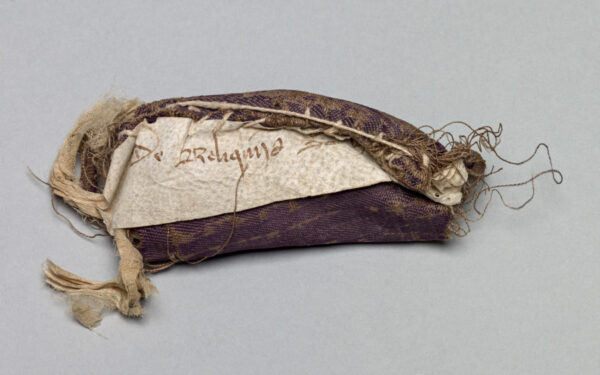This resource is part of the Silk Roads and Beyond: Trade, Exchange, and Travel in Ancient and Medieval Afro-Eurasia toolkit, from the AHA’s Teaching Things project.
Introduction
While only legends persist about how and when silk-making expanded beyond China, it is evident that silk was a significant aspect of European economies and cultural practices by the early Middle Ages.
This Object Lesson explores the preciousness of silk in western European cultures in the Middle Ages, particularly in the context of its religious functions.
Part I: Contexts
Read these two brief articles that provide an overview of medieval Christianity and religious practice:
- Beth Harris, Steven Zucker and Nancy Ross, “Christianity, an introduction,” Smarthistory, August 8, 2015
- Jennifer Awes Freeman, “Architecture and liturgy,” Smarthistory, August 8, 2015
Part II: Holding Relics
Relics and reliquaries were extraordinarily significant aspects of Christian religious practice in western Europe throughout the Middle Ages. As described in this essay by Metropolitan Museum of Art curator Barbara Drake Boehm, relics—which could range from the bodily remains of holy figures to objects like cloth that touched them during life or after death—were placed in reliquary containers meant to emphasize their sacred preciousness. Yet they were often wrapped in another layer within the reliquaries themselves: silk textiles.
Have students watch the video and closely examine the following images of the Portable Altar of Countess Gertrude (c. 1045), the relic of St. Hermetis wrapped in silk, as well as the Fragment of a Reliquary Bag (1250–99), all of which are in the collections of the Cleveland Museum of Art. Image of additional relics contained in the box are available on the Cleveland Museum’s website.
“Examining the Altar” video about Portable Altar of Countess Gertrude, The Cleveland Museum of Art, Gift of the John Huntington Art and Polytechnic Trust 1931.462. Watch on the Museum’s website.

Portable Altar of Countess Gertrude, c. 1045. Germany, Possibly Lower Saxony, Romanesque period, 11th century. Gold, cloisonné enamel, porphyry, gems, pearls, niello, wood core; overall: 10.5 × 27.5 × 21 cm (4 1/8 × 10 13/16 × 8 1/4 in.). Cleveland Museum of Art, Gift of the John Huntington Art and Polytechnic Trust, 1931.462.

Portable Altar of Countess Gertrude, c. 1045. Germany, Possibly Lower Saxony, Romanesque period, 11th century. Gold, cloisonné enamel, porphyry, gems, pearls, niello, wood core; overall: 10.5 × 27.5 × 21 cm (4 1/8 × 10 13/16 × 8 1/4 in.). Cleveland Museum of Art, Gift of the John Huntington Art and Polytechnic Trust 1931.462.

Relic of St. Hermetis, Romanesque period, 11th century. Germany, Possibly Lower Saxony, Bone, compound weave or samite. Cleveland Museum of Art, Gift of the John Huntington Art and Polytechnic Trust 1931.462.
This relic is a long bone from a human arm or leg. It was enclosed in the portable altar commissioned by Countess Gertrude of Brunswick.

Fragment of a Reliquary Bag, 1250–1299. France, last half 13th century. Tapestry weave fragment with tablet woven band along top edge; silk and metal thread; overall: 12.1 × 18.4 cm (4 3/4 × 7 1/4 in.). Cleveland Museum of Art, Purchase from the J. H. Wade Fund 1939.37.
Discussion questions
- Consider the original contexts and functions of the portable altar versus the reliquary bag.
- How do these object’s materials differ? Do these materials serve some functional purpose?
- What is similar about these objects?
- Of all available materials, why would medieval Latin Christians choose to wrap relics in silk? What does this practice indicate about the significance of this textile and the objects wrapped within?
- Are there examples from modern life of important items wrapped or stored in precious materials or objects?
Part III: Religious Vestments
The preciousness and religious significance of silk extended beyond relics. Silk served important liturgical functions and was used often in vestments, or clothing, worn by important religious figures.
Assign students to read John T. Doherty, Jane Hayward, John K. Howat, Timothy B. Husband, Dobrila-Donya Schimansky, and Bonnie Young, “Ecclesiastical Vestments of the Middle Ages: An Exhibition,” The Metropolitan Museum of Art Bulletin 29, no. 7 (March 1971): 285–312.
In class, students should begin by closely examining the Netherlandish painting, “Scenes from the Life of Saint Augustine of Hippo” (c. 1490), which includes a variety of vestments and altar objects. What stands out to them in the image? What questions do they have? Play the available audio recording of a Metropolitan Museum of Art expert describing the artwork’s story.
Having read the article, examined the painting, and listened to the expert’s description, students should engage in a classroom discussion about what can clothing can communicate about a person or a practice.

Scenes from the Life of Saint Augustine of Hippo, ca. 1490, Master of Saint Augustine, Netherlandish. The Cloisters Collection, 1961. 61.199. Metropolitan Museum of Art.
Additional Reading
Burns, E. Jane. Sea of Silk: A Textile Geography of Women’s Work in Medieval French Literature (Philadelphia: University of Pennsylvania Press: 2009).
Farmer, Sharon. The Silk Industries of Medieval Paris: Artisanal Migration, Technological Innovation, and Gendered Experience (Philadelphia: University of Pennsylvania Press: 2016).
Garver, Valerie L. “Material Culture and Social History in Early Medieval Western Europe,” History Compass 12, no. 10 (October 2014): 784–93.



